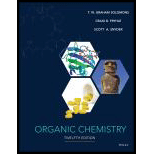
EBK ORGANIC CHEMISTRY
12th Edition
ISBN: 9781119233664
Author: Snyder
Publisher: VST
expand_more
expand_more
format_list_bulleted
Concept explainers
Question
Chapter 1, Problem 24PP
Interpretation Introduction
Interpretation:
The hybridization of oxygen atom in a water molecule as indicated by the bond angles is to be predicted.
Concept Introduction:
A tetrahedral geometry has
A tetrahedral geometry that containstwo lone pairs of electrons, has anangular or bent shape.
Expert Solution & Answer
Want to see the full answer?
Check out a sample textbook solution
Students have asked these similar questions
Please help me solve this reaction.
Indicate the products obtained by mixing 2,2-dimethylpropanal with acetaldehyde and sodium ethoxide in ethanol.
Synthesize 2-Ethyl-3-methyloxirane from dimethyl(propyl)sulfonium iodide using the necessary organic or inorganic reagents. Draw the structures of the compounds.
Chapter 1 Solutions
EBK ORGANIC CHEMISTRY
Ch. 1 - Prob. 1PPCh. 1 - Prob. 2PPCh. 1 - Prob. 3PPCh. 1 - Prob. 4PPCh. 1 - Prob. 5PPCh. 1 - Prob. 6PPCh. 1 - Prob. 7PPCh. 1 - Prob. 8PPCh. 1 - Prob. 9PPCh. 1 - Prob. 10PP
Ch. 1 - Prob. 11PPCh. 1 - Prob. 12PPCh. 1 - Prob. 13PPCh. 1 - Prob. 14PPCh. 1 - Prob. 15PPCh. 1 - Prob. 16PPCh. 1 - Prob. 17PPCh. 1 - Prob. 18PPCh. 1 - Prob. 19PPCh. 1 - Prob. 20PPCh. 1 - Prob. 21PPCh. 1 - Practice Problem 1.22 Which of the following...Ch. 1 - Prob. 23PPCh. 1 - Prob. 24PPCh. 1 - Practice Problem 1.25
What do the bond angles of...Ch. 1 - Prob. 26PPCh. 1 - Practice Problem 1.27
Use VSEPR theory to predict...Ch. 1 - Practice Problem 1.28 Predict the bond angles of...Ch. 1 - 1.29 Which of the following ions possess the...Ch. 1 - 1.30 Write a Lewis structure for each of the...Ch. 1 - Prob. 31PCh. 1 - Add any unshared electrons to give each element an...Ch. 1 - Prob. 33PCh. 1 - What is the molecular formula for each of the...Ch. 1 - Prob. 35PCh. 1 - Prob. 36PCh. 1 - 1.37 Write bond-line formulas for all of the...Ch. 1 - Prob. 38PCh. 1 - Prob. 39PCh. 1 - Prob. 40PCh. 1 - Prob. 41PCh. 1 - (a) Cyanic acid (HOCN) and isocyanic acid (HN=C=O)...Ch. 1 - Consider a chemical species (either a molecule or...Ch. 1 - 1.44 Consider a chemical species like the one in...Ch. 1 - 1.45 Consider another chemical species like the...Ch. 1 - Draw a three-dimensional orbital representation...Ch. 1 - Ozone (O3) is found in the upper atmosphere where...Ch. 1 - Write resonance structures for the azide ion, N3....Ch. 1 - Write structural formulas of the type indicated:...Ch. 1 - Prob. 50PCh. 1 - 1.51 In Chapter 15 we shall learn how the...Ch. 1 - Prob. 52PCh. 1 - (a) Consider a carbon atom in its ground state....Ch. 1 - Open computer molecular models for dimethyl ether,...Ch. 1 - Boron is a group IIIA element. Open the molecular...Ch. 1 - 1.56 There are two contributing resonance...Ch. 1 - Prob. 1LGPCh. 1 - Consider the compound with the following condensed...Ch. 1 - Consider the compound with the following condensed...Ch. 1 - Consider the compound with the following condensed...Ch. 1 - Consider the compound with the following condensed...Ch. 1 - Consider the compound with the following condensed...Ch. 1 - Prob. 7LGPCh. 1 - Prob. 8LGP
Knowledge Booster
Learn more about
Need a deep-dive on the concept behind this application? Look no further. Learn more about this topic, chemistry and related others by exploring similar questions and additional content below.Similar questions
- Synthesize 2-Hydroxy-2-phenylacetonitrile from phenylmethanol using the necessary organic or inorganic reagents. Draw the structures of the compounds.arrow_forwardSynthesize N-Methylcyclohexylamine from cyclohexanol using the necessary organic or inorganic reagents. Draw the structures of the compounds.arrow_forwardSynthesize N-Methylcyclohexylamine from cyclohexanol using the necessary organic or inorganic reagents. Draw the structures of the compounds.arrow_forward
- If possible, please provide the formula of the compound 3,3-dimethylbut-2-enal.arrow_forwardSynthesize 1,4-dibromobenzene from acetanilide (N-phenylacetamide) using the necessary organic or inorganic reagents. Draw the structures of the compounds.arrow_forwardIndicate the products obtained by mixing (3-oxo-3-phenylpropyl)triphenylphosphonium bromide with sodium hydride.arrow_forward
- We mix N-ethyl-2-hexanamine with excess methyl iodide and followed by heating with aqueous Ag2O. Indicate the major products obtained.arrow_forwardIndicate the products obtained by mixing acetophenone with iodine and NaOH.arrow_forwardIndicate the products obtained by mixing 2-Propanone and ethyllithium and performing a subsequent acid hydrolysis.arrow_forward
- Indicate the products obtained if (E)-2-butenal and 3-oxo-butanenitrile are mixed with sodium ethoxide in ethanol.arrow_forwardQuestion 3 (4 points), Draw a full arrow-pushing mechanism for the following reaction Please draw all structures clearly. Note that this intramolecular cyclization is analogous to the mechanism for halohydrin formation. COH Br + HBr Brarrow_forwardIndicate the products obtained if 2,2-dimethylpropanal and acetaldehyde are mixed with sodium ethoxide in ethanol.arrow_forward
arrow_back_ios
SEE MORE QUESTIONS
arrow_forward_ios
Recommended textbooks for you
 Organic Chemistry: A Guided InquiryChemistryISBN:9780618974122Author:Andrei StraumanisPublisher:Cengage Learning
Organic Chemistry: A Guided InquiryChemistryISBN:9780618974122Author:Andrei StraumanisPublisher:Cengage Learning

Organic Chemistry: A Guided Inquiry
Chemistry
ISBN:9780618974122
Author:Andrei Straumanis
Publisher:Cengage Learning